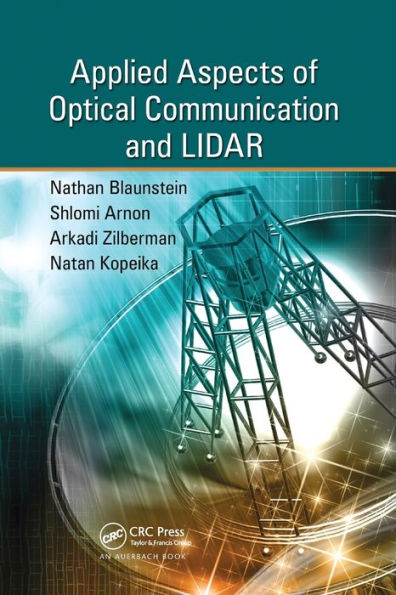Table of Contents
Preface ix
Acknowledgments xiii
About the Authors xv
Chapter 1 Atmosphere: Structure and Processes 1
1.1 Vertical Profiles of Temperature, Pressure, and Number Density 1
1.2 Aerosols 2
1.2.1 Aerosol Loading 4
1.2.2 Aerosol Size Distribution and Spectral Extinction 7
1.3 Hydrometeors 12
1.3.1 Fog 12
1.3.2 Rain 13
1.3.3 Clouds 13
1.3.3.1 First Cloud Cover Model 14
1.3.3.2 Second Cloud Cover Model 14
1.3.3.3 Third Cloud Cover Model 15
1.3.3.4 Ceiling Cloud Model 15
1.3.4 Snow 15
1.4 Atmospheric Turbulence 16
1.4.1 Energy Cascade Theory 16
1.4.2 Spectral Characteristics 21
1.4.3 C2n Altitude Distribution 24
1.4.4 L0 Altitude Distribution 26
1.4.5 Non-Kolmogorov Turbulence 28
1.4.6 Generalized Power Spectrum 31
References 33
Chapter 2 Optical Wave Propagation in the Atmosphere 41
2.1 Refraction Phenomena 41
2.2 Effects of Aerosols 43
2.2.1 Attenuation of Aerosols 44
2.2.2 Scattering by Aerosols 45
2.3 Aerosol Effects on Optical Wave Propagation 46
2.3.1 Atmospheric Transmission 49
2.3.2 Aerosol Beam Widening 50
2.4 Effects of Hydrometeors 53
2.4.1 Effects of Clouds and Fog 53
2.4.2 Effects of Rain 54
2.5 Effects of Atmospheric Turbulence on Optical Propagation 55
2.5.1 Scintillations 57
2.5.2 Beam Wander and Angle of Arrival of Optical Wave 63
2.6 Measurements of Atmospheric Turbulence 80
2.7 Modeling of Atmospheric Optical Turbulence 82
2.7.1 Analytical Models 82
2.7.2 Empirical and Semi-Empirical Models 83
2.7.2.1 Concept and Applications of Thiermann (MOS) Model 84
2.7.2.2 Macroscale Meteorological Model 87
2.7.2.3 Extension of the Macroscale Meteorological Model 92
2.8 Line-of-Sight Bending Caused by Strong Atmospheric Turbulence 97
2.8.1 Modeling of Line-of-Sight Bending 99
2.8.2 Boundary Layer Turbulence Modeling 100
2.8.3 Fluctuations of the Refractive Index 104
2.8.4 Line-of-Sight Bending Prediction 107 References 114
Chapter 3 Applied Aspects of Lidar 123
3.1 Turbulence Profile Measurement with Lidar 125
3.1.1 Imaging Lidar Principle 126
3.1.2 Practical Considerations 131
3.1.3 Lidar Inaccuracy 134
3.1.4 C2n Retrieval Technique 141
3.2 Lidar Research of Passive Scalar Field Fluctuations 144
3.2.1 Lidar Method for Turbulence Spectrum Estimation 145
3.3 Lidar Measurement of Atmospheric Aerosol Parameters 152
References 162
Chapter 4 Optical Communication Channels 171
4.1 Main Characteristics 171
4.1.1 Block Diagram of the Communication System 173
4.1.2 Link Budget 176
4.2 Key Parameters Prediction 180
4.3 Mathematical and Statistical Description of Signal Fading 181
4.3.1 Lognormal Probability Density Function 183
4.3.2 Gamma-Gamma Density Distribution Function 184
4.3.3 K Probability Density Distribution Function 186
4.4 Modulation Methods 186
4.4.1 On-Off Keying Modulation 188
4.4.2 Pulse Amplitude Modulation 193
4.4.3 Pulse Position Modulation 194
4.4.4 The Effect of Turbulence on OOK System Analysis 195
4.4.5 Mitigating Atmospheric Turbulence Effects 198
4.4.6 Performance of an OWC as a Function of Wavelength 198
References 201
Chapter 5 Channel and Signal Data Parameters in Atmospheric Optical Communication Links 205
5.1 Irradiance PDF 206
5.1.1 Gamma-Gamma Distribution 207
5.1.2 Ricean Distribution 208
5.2 Key Parameters of Data Stream in Optical Channels with Fading 210
5.2.1 BER of Optical Channel 210
5.2.2 Channel Capacity and Spectral Efficiency 211
5.2.2.1 Classical Approach 212
5.2.2.2 Approximate Approach 213
5.3 Modeling of Key Parameters of the Channel and Information Data 218
5.4 Summary 235
References 236
Abbreviations 241
Index 245




